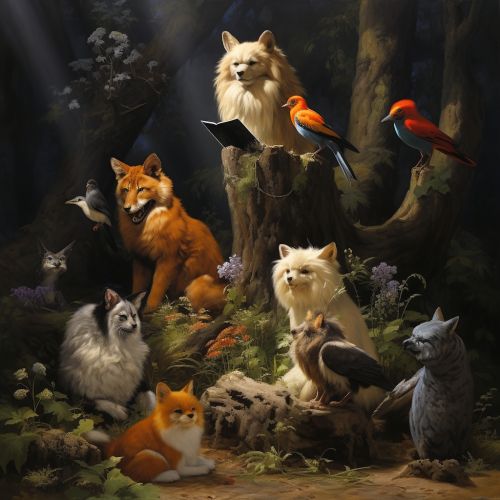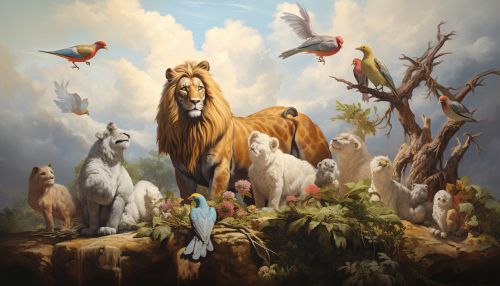The Science of Animal Communication and Information Transfer
Introduction
The science of animal communication and information transfer is a complex and fascinating field of study that explores how animals interact with each other and their environment. This discipline, part of the broader field of ethology, delves into the various methods and mechanisms animals use to communicate, ranging from visual and auditory signals to chemical and tactile cues.


Types of Animal Communication
There are several types of animal communication, each with its unique characteristics and functions. These include:
- Acoustic communication: This involves the use of sound signals, such as bird songs, wolf howls, or dolphin clicks. Acoustic communication is often used for long-distance communication and can convey a wide range of information, including territorial claims, mating calls, and warning signals.
- Visual communication: Animals use visual signals to communicate, such as body postures, color changes, or flashing lights (as seen in fireflies). Visual communication is typically used for short-range interactions and can be highly specific and complex.
- Chemical communication: Many animals communicate using chemical signals or pheromones. These can be used to mark territory, signal readiness for mating, or warn of danger. Chemical communication is often used by insects, but it is also prevalent in mammals.
- Tactile communication: This involves physical contact between animals, such as grooming, nuzzling, or wrestling. Tactile communication can serve to reinforce social bonds, establish dominance hierarchies, or convey comfort and reassurance.
- Electrical communication: Some aquatic animals, such as electric fish, use electric fields to communicate. This form of communication is less common but offers unique advantages in environments where other forms of communication are less effective.
Mechanisms of Animal Communication
The mechanisms of animal communication involve the processes by which signals are produced, transmitted, received, and interpreted. These mechanisms can be highly complex and are shaped by a variety of factors, including the animal's physiological capabilities, environmental conditions, and evolutionary pressures.
- Signal production: This involves the physiological processes by which an animal produces a signal. For example, a bird may use its vocal cords to produce a song, or a firefly may produce light through bioluminescence.
- Signal transmission: Once a signal is produced, it must be transmitted to the receiver. The mode of transmission can vary depending on the type of signal and the environment. For example, sound signals are transmitted through air or water, while chemical signals are often transmitted through the air or soil.
- Signal reception: The receiver must have the physiological capabilities to detect the signal. This often involves specialized sensory organs, such as ears for sound signals, eyes for visual signals, or antennae for chemical signals.
- Signal interpretation: Once a signal is received, the animal must interpret it correctly to respond appropriately. This involves cognitive processes and can be influenced by the animal's previous experiences, current state, and environmental context.
Evolution of Animal Communication
The evolution of animal communication is a subject of ongoing research and debate among scientists. It is generally agreed that animal communication systems have evolved through natural selection to convey information that enhances the survival and reproductive success of the communicating animals.
There are several theories that attempt to explain the evolution of animal communication, including:
- Kin selection theory: This theory suggests that animals are more likely to communicate with close relatives because they share a significant proportion of their genes. By helping their relatives survive and reproduce, animals can indirectly pass on their own genes.
- Game theory: This theory applies mathematical models to predict the outcomes of interactions between animals. It suggests that animal communication can be seen as a strategic game, where the best strategy depends on the strategies used by others.
- Signal evolution theory: This theory proposes that signals evolve to be more effective in conveying information. This can involve changes in the signal's structure, timing, or context of use.
Communication and Animal Behavior
Animal communication plays a crucial role in various aspects of animal behavior, including:
- Territorial behavior: Animals often use communication signals to establish and defend their territories. This can involve vocal calls, scent marking, or visual displays.
- Mating behavior: Communication is essential in the mating rituals of many animals. Males often use signals to attract females, while females use signals to indicate their receptivity.
- Social behavior': In social species, communication is vital for maintaining group cohesion and coordinating collective actions. This can involve alarm calls, grooming behaviors, or dominance displays.
- Parental behavior: Parent animals often use communication to interact with their offspring, such as guiding them, warning them of danger, or teaching them skills.
Challenges and Future Directions in the Study of Animal Communication
Despite significant advances in our understanding of animal communication, there remain many challenges and unanswered questions. Future research in this field may focus on areas such as:
- Cognitive processes in animal communication: Understanding the cognitive mechanisms underlying signal production, reception, and interpretation remains a significant challenge. This involves studying animal cognition and behavior in both laboratory and natural settings.
- Impact of human activities on animal communication: Human activities, such as habitat destruction, noise pollution, and climate change, can disrupt animal communication systems. Understanding these impacts and developing strategies to mitigate them is a crucial area of research.
- Comparative studies of animal communication: Comparing communication systems across different species can provide insights into the evolutionary processes that shape animal communication. This requires interdisciplinary collaboration and the development of new methodologies and analytical tools.
